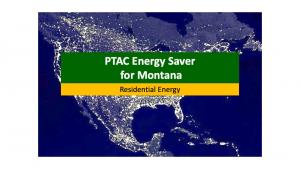- 16 reads

Our GREENandSAVE Team is pleased to share information like this about sustainability solution providers. If you would like to submit information on your company, please contact us.
TIME TO ACT: Save 20% or more on HVAC. It’s important now more than ever for a sustainable future!
Optimizing PTAC units with a “smart” device is a fast, easy, and cost-effective way to achieve Residential HVAC Energy Savings. A Packaged Terminal Air Conditioner is a type of self-contained heating and air conditioning system commonly found in: Hotels, Motels, Senior Housing Facilities, Hospitals, Condominiums, Apartment Buildings, and Add-on Rooms & Sunrooms.
Business owners and homeowners face increasing challenges with energy costs to save energy and money in Montana PTAC Energy Saver offers an Adaptive Climate Controller (ACC). It is a proven HVAC energy saving devicethat quickly installs on PTAC units. There are many companies that claim to produce energy savings, but the ACC device is multi-panted and proven over many years. Plus, it has extensive validation tests by organizations such as:
- ConEdison, Manhattan Plaza New York City
- Environmental Test Laboratory, Ohio
- EME Consulting Engineers (Third Party), Sponsored by NYSERDA, New York
- State University of New York, Oneonta, NY
- Tim Garrison (Third Party Testing)
- McQuay Cooling Tests
- Purdue University Tests (Phoenix)
- ConEdison Tests by ERS
Typically, when an HVAC system turns off, shortly after, the blower fan motor turns off. The ACC reprograms the blower fan not to shut off but to throttle back the rpm airflow to an exceptionally low speed, quiescent level airflow or “idle speed”. This allows for a gentle but continuous air movement into the building that helps keep equilibrium of climate conditions in the occupied space and saved energy.
PTAC Energy Saver can help you navigate the complexity of HVAC energy saving choices: CONTACT PTAC Energy Saver
Here is an example of some Residential HVAC Energy Saving info for Montana:
Efficient Dehumidifier Makes Air Conditioning a Breeze
It’s a dry heat! When you hear someone say that, they’re implying it’s easier to handle than heat combined with humidity. That’s certainly true of air conditioning (A/C) units. If the air is dry, they don’t have to work so hard and, therefore, don’t consume as much electricity.
A new technology is set to provide that drier air via a dehumidification system that uses 10 to 30 times less energy than standard dehumidifiers. The patent-pending system is also one-third the size and 40 percent lighter than conventional machines. These benefits make dehumidification practical and affordable for homes and buildings. And the technology can have a significant energy savings impact on vehicles as well.
The novel dehumidification system, developed by Pacific Northwest National Laboratory (PNNL), has been licensed to Montana Technologies, a development company with expertise and products that support electric vehicle energy management and advanced powertrains.
Montana Technologies estimates that the dehumidifier units will reduce dehumidification cost for buildings by nearly half. But the company plans to target vehicles first to help decarbonize the transportation sector.
“There’s a huge opportunity in electric vehicles (EVs) and particularly electric buses because integration of our dehumidifiers in their air conditioning systems can extend their driving ranges by up to 75 percent,” said Matt Jore, CEO of Montana Technologies. “Cooling humid air causes a huge power draw on an EV battery. In fact, air conditioning an electric bus stuck in congested traffic draws more power than propelling it down the road.”
Thermal balancing act
Air conditioners condense water vapor into liquid water as part of the cooling process—think of the water dripping out of the bottom of A/C systems. But that condensation process generates significant heat, forcing the A/C system to use 3–7 times as much energy to keep people in a building or vehicle cool.
PNNL’s new dehumidification technology eliminates condensation on the evaporators in traditional A/C systems. Montana Technologies calls the device AirJoule®, with Joule denoting a unit of energy. The name is apropos because the AirJoule dehumidification process “harvests” energy generated spontaneously from adsorbing the water vapor in the air. The system uses a twin-chamber design, in which both chambers contain a novel desiccant material that has exceptional adsorption properties. Each chamber takes turns either removing moisture from air or regenerating the desiccant for reuse.
In one chamber, outside air is passed over the paper-thin film of desiccant, pulling water vapor into the material’s nano-sized pores. The heat that is generated from adsorbing water vapor is then transferred to the other chamber to help release water previously captured in the pores. A light vacuum pressure helps regenerate the desiccant.

